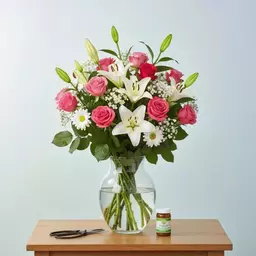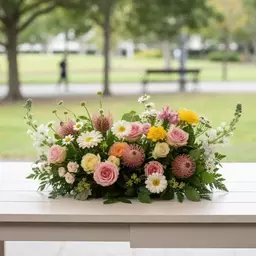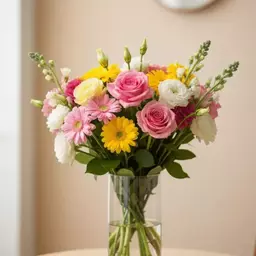Did you know that proper flower care can extend the life of your blooms significantly? With just a few key practices, you can enjoy beautiful arrangements for days longer than usual. Let's explore the essential lessons behind nurturing your flowers to keep them vibrant and fresh!
What You Will Learn
- Regularly change the water in your vase to prevent bacteria growth and ensure hydration.
- Keep flowers in a cool, stable environment away from direct sunlight for optimal longevity.
- Trim flower stems at an angle to improve water absorption and overall health.
- Avoid placing flowers near ripe fruits or vegetables, as they release ethylene gas which can accelerate wilting.
- Recognize signs of drooping or wilting and take immediate corrective actions to revive your blooms.
- Utilize infographics and videos to further enhance your understanding of flower care techniques.
Environmental Factors Affecting Flower Longevity
Understanding the major environmental factors that impact the lifespan of cut flowers can help in maximizing their beauty and longevity. For a comprehensive guide on maintaining your floral arrangements, check out our article on caring for fresh flowers at home.
Temperature
Keep flowers in a cool spot (ideally 18-22°C) to prevent premature wilting.
Humidity
Higher humidity can help, but be careful of mold. Create a balance for optimal flower health.
Light Exposure
Avoid direct sunlight and heat sources to maintain flower hydration and vigor.
Air Circulation
Ensure a gentle breeze around the flowers; stifling conditions can cause wilting.
Understanding the Importance of Flower Care for Longevity
When it comes to enjoying fresh flowers, proper care can make all the difference. Just think about it—there’s nothing quite like watching a beautifully arranged bouquet brighten your home! At the Pakenham Florist Guide, I’m passionate about sharing the secrets behind keeping those blooms looking their best for as long as possible. In this section, we’ll explore why flower care is vital, the key factors that influence their lifespan, and what you can do to maximize their beauty.
Why Proper Care Extends the Life of Cut Flowers
Proper care extends the life of cut flowers by addressing their basic needs. Flowers, like us, require the right environment to thrive! By understanding how to meet these needs, you can keep your floral arrangements vibrant and lively for days to come.
One of the biggest factors is water quality and availability. Flowers absorb water through their stems, and if their hydration levels are low, they start to wilt. A simple change in care methods can make all the difference, ensuring they stay fresh and healthy.
- Consistent water changes to prevent bacteria growth.
- Using clean vases to minimize contamination.
- Cutting stems at an angle to enhance water absorption.
Key Factors Influencing Flower Lifespan
Several factors influence how long your flowers will last, and being aware of these can help you create the perfect environment for your blooms. Temperature, humidity, and light exposure all play significant roles. For instance, flowers generally prefer cooler temperatures, away from direct sunlight, which can quickly dehydrate them.
Moreover, the flower type also matters! Some flowers naturally have a shorter lifespan, while others can last for weeks with the right care. Understanding these differences can help you choose the best options for your occasion. To learn more about common mistakes to avoid, see our guide on avoiding flower care mistakes.
- Temperature: Keep flowers in a cool spot (ideally 18-22°C).
- Humidity: Higher humidity can help, but be careful of mold.
- Light: Avoid direct sunlight and heat sources.
Environmental Factors Affecting Flower Longevity
Environmental conditions have a considerable impact on flower longevity. For example, flowers thrive in a stable environment where temperature and humidity don’t fluctuate too much. If you want your blooms to last longer, it’s essential to place them in a location that meets these criteria.
Additionally, air circulation plays a role. A space that’s too stuffy can cause flowers to wilt faster. So, when arranging your blooms, select a spot that allows for a gentle breeze to circulate around them!
Understanding Ethylene Gas and Its Impact on Flowers
Did you know that ethylene gas can be both a friend and a foe to your flowers? Ethylene is a natural plant hormone that promotes ripening and aging. While it’s essential for fruit, it can cause cut flowers to wilt prematurely!
To combat this, keep your blooms away from ripe fruits and vegetables, as they release ethylene gas. Just a little consideration can help your flowers stay fresh and vibrant for longer.
By understanding the importance of flower care, you can make informed choices that will enhance the beauty and longevity of your floral arrangements. Remember, as a local advocate for floristry, I’m here to help you nurture and celebrate the joy that fresh flowers bring to your life! So let's dive deeper into essential practices that will keep your cut flowers looking fabulous.
Quick Summary
Here's a brief recap of the key points discussed so far:
- Proper care extends the life of cut flowers by addressing their hydration and environmental needs.
- Key factors influencing flower lifespan include temperature, humidity, and light exposure.
- Understanding ethylene gas and keeping flowers away from ripe fruits can help maintain their freshness.
Troubleshooting Common Issues with Cut Flowers
Even with the best care, cut flowers can sometimes face challenges! It's essential to recognize and address these issues promptly, ensuring your beautiful blooms stay vibrant for as long as possible. In this section, I’ll share some common problems you might encounter and practical solutions that can help revive your flowers.
Identifying and Reviving Drooping Flowers
When flowers start to droop, it can be quite disheartening. But fear not! Understanding the common mistakes that lead to premature wilting can help you correct them quickly. Some typical culprits include:
- Not changing the water regularly
- Using a dirty vase
- Improper stem preparation
Once you've identified the issue, you can take action! Here are some step-by-step revival techniques that can work wonders:
- Remove any wilted leaves or flowers to minimize bacterial growth.
- Trim the stems at an angle to improve water uptake.
- Place the flowers in fresh, clean water and give them a little time to perk up.
If your flowers continue to struggle, it’s important to check for less visible problems like fungal infections or pesticide residues. These can be tricky, but keeping an eye on your flowers can help you catch any signs early! For more insights, explore Pakenham's best flower shops for expert advice.
Addressing Water Clarity and Odor Problems
Cloudy water or unpleasant odors can be signs that your flowers aren't getting the care they need! This not only affects the appearance of your arrangement but can also shorten its lifespan. Preventing these issues is key, so here are some strategies:
- Always start with clean vases and fresh water.
- Change the water every couple of days to keep it clear.
- Ensure that the flowers are free from any leaves that might sit below the water line.
When it comes to changing the water, I recommend doing it every two to three days. It not only keeps your vase looking fresh but also ensures your flowers stay hydrated and happy!
Encouraging Engagement and Further Learning
As we dive deeper into the world of flower care, I want to keep the conversation going! Understanding cut flower care can feel overwhelming, but addressing common questions can help us all feel more confident in our floral endeavors.
Frequently Asked Questions About Cut Flower Care
One question I often hear is, “How often should I change the water in my vase?” As mentioned, changing the water every two to three days is ideal for keeping your flowers thriving!
Another frequently asked question is, “Are DIY solutions as effective as commercial products?” While many home remedies can be effective, commercial floral preservatives are specifically designed to nourish flowers and can work wonders when used correctly.
Frequently Asked Questions
- How often should I change the water for my cut flowers?
- You should change the water every two to three days to prevent bacterial growth and ensure proper hydration.
- What is the ideal temperature for cut flowers?
- Keep flowers in a cool spot, ideally between 18-22°C (64-72°F), to prevent premature wilting.
- Why should I trim flower stems at an angle?
- Trimming stems at an angle increases the surface area for water absorption, helping the flowers stay hydrated more effectively.
- What is ethylene gas, and how does it affect flowers?
- Ethylene gas is a natural plant hormone that accelerates ripening and aging in flowers, causing them to wilt prematurely. Keep flowers away from ripe fruits and vegetables, which release this gas.
- How can I revive drooping flowers?
- Remove any wilted leaves, trim the stems at an angle, and place them in fresh, clean water. This often helps them perk up.
Visual Learning Aids and Resources
To further enhance your understanding of flower care, I encourage you to explore visual learning aids. Infographics and videos can make complex information easier to digest and more engaging. Some great resources include:
- YouTube tutorials on flower care techniques
- Infographics that outline flower-specific needs
- Links to expert opinions and articles on floral care
At the Pakenham Florist Guide, we’re committed to connecting you with all the knowledge you need to keep your flowers healthy and beautiful. So, let’s keep learning together and make every floral experience a delight! For more local tips, discover seasonal flowers from Pakenham florists.
Recap of Key Points
Here is a quick recap of the important points discussed in the article:
- Proper care, including water quality and stem preparation, is essential for extending the life of cut flowers.
- Key environmental factors such as temperature, humidity, and light exposure significantly influence flower longevity.
- Ethylene gas can lead to premature wilting, so keep flowers away from ripe fruits and vegetables.
- Regularly changing water and using clean vases helps prevent bacterial growth and odor issues.
- If flowers droop, remove wilted parts, trim stems, and refresh with clean water to rejuvenate them.
- Explore visual aids and resources for a deeper understanding of flower care techniques.




